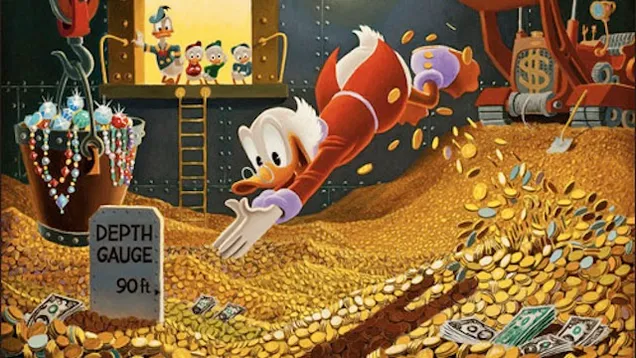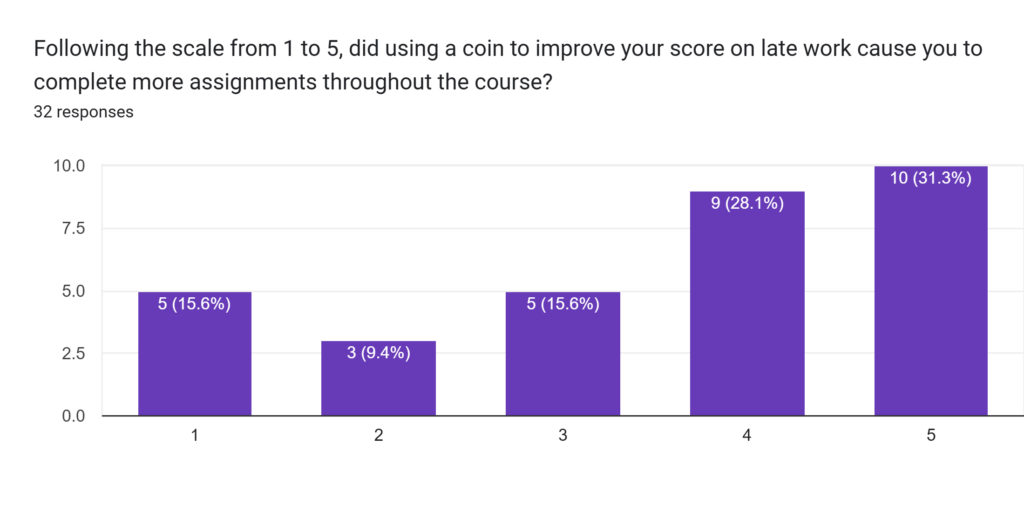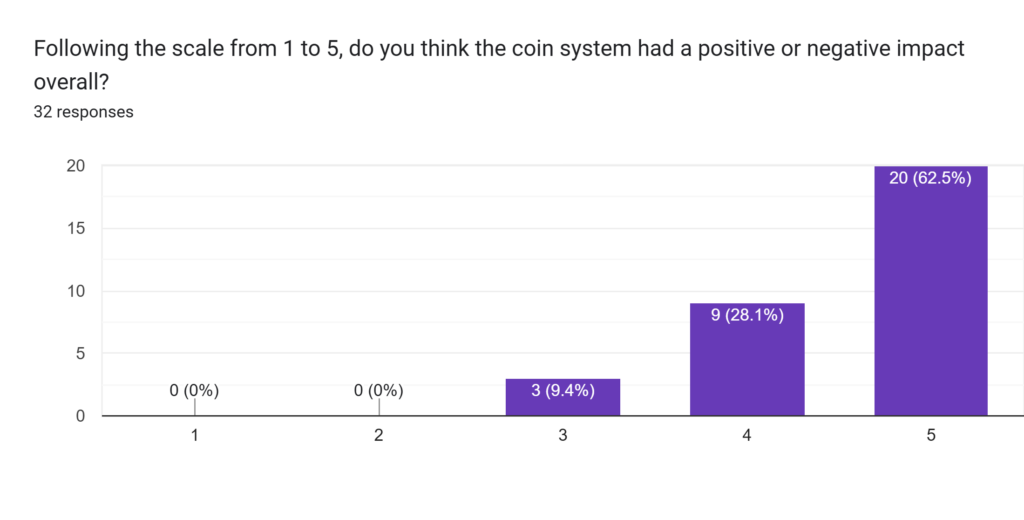In semester 2 of 2024, I created an in-class incentive scheme that rewarded students for simple in-class, pro-learning behaviours like speaking up when questions were asked, volunteering to present their group’s work, as a prize for scoring well on a in-class Kahoot! quiz, and even in some cases, just turning up to class on time! Students were awarded plastic coins which they could then exchange for different items or academic bonuses.1Ruch, A. (2024) “Toss a Coin to Your Learners” Flickering Colours [Blog post] retrieved April 10, 2024.

I did not track my data exceptionally precisely, so this discussion of results will necessarily be fairly casual. The classes involved were two 100-level College Composition courses, and one ‘remedial’ academic skills course. The composition sections were at one community college while the academic skills course was at a different but similar community college. In all I taught about 50 students, with the academic skills class being noticeably smaller than the two composition sections. I estimate that in total I handed out 200 or so coins across the three sections.
From the outset, I presented the students with a “menu” of items or bonuses they could use their coins to buy. I focused mainly on the academic benefits, trying to align the idea with “extra credit” opportunities that might be a more familiar part of any other course. Later in the semester, I began to bring in a chest of small prizes that students could purchase with their coins. These included pens and highlighters, stickers and enamel pins–nothing very expensive and nothing beyond the scope of what an instructor might provide for some other kind of ‘contest’ in the classroom.
At the end of the semester, I ran an online, anonymous Google Forms survey to gather feedback from students. I received 32 responses.

Student Participation: I was not explicit with how and when I would make coins available. This created an imaginary tension, a promise that coins might be available. My hope here was that students would participate more, even if participation amounted only to attending. Students reported a very positive correlation here.

Late Penalty: The most popular use of coins was to erase a late penalty on submitted work. I received many of these requests, and depending on the severity of the lateness I would charge from 1 to 3 coins to reset a late penalty to zero. My thinking here was that instead of offering an entirely new exercise, I could simply require the student to finish the original assignment presented, which would still benefit their learning, without generating any additional grading work for myself. This proved very popular, with around 20 instances of students submitting work late, then asking for the penalty to be removed.

Fairness / Equity: I was somewhat concerned with presenting the system as fair and equitable to all students, not just as a benefit to those who fall behind. The availability of the small prizes was designed to a) tempt students to spend coins early on non-academic benefits and b) ensure that students who never needed a bonus were still motivated, even if only slightly, to participate in the game. Only a few students ended up buying these, but it was effective enough that I feel it was worthwhile. Certainly those few who bought a few stickers enjoyed that element.

Students reported no problem with the fairness or equity of the system, in either case.

Issues: As I expected, balancing the “economy” was a bit tricky. My initial prices for each of the bonuses and services was a bit high (or, conversely, I wasn’t handing coins out fast enough to be realistic). I therefore had to start making more individual “deals” by bartering with students on a case-by-case basis. I was fairly public about this, and do not believe that it negatively impacted the game as such, but would definitely be a problem in a larger cohort with multiple instructors involved.
Overall Impact: In the end, my students reported an overwhelmingly positive reaction to the system. I predicted that there would be at least a small percentage of students who would gain a sense of agency which threats of late penalties can erase. Although I did enact a fairly harsh late penalty, I observed several students calculating whether it was still “worth it” for them to finish and submit late work. It always was, and I feel that this kept students who had fallen behind from giving up entirely. This does, of course, create the opportunity for students to game the system some–but given that the only way to gain a coin* was to win my favour during class time anyway, I was, ultimately, able to reward the kind of positive behaviour I was looking for and simply ignore others. In all, I am very pleased with how this little experiment went, and I would be very happy to run it again with slightly more strict controls and data recording in place.

*N.B. I never explicitly forbade students from trading or donating coins, and did not track the amounts paid out to individuals well enough to catch it. I did even observe one student donate a coin to another at the very end of the course, which I felt was a positive social interaction that outweighed any concerns over 1 or 2% added to a student’s grade.
References
- 1